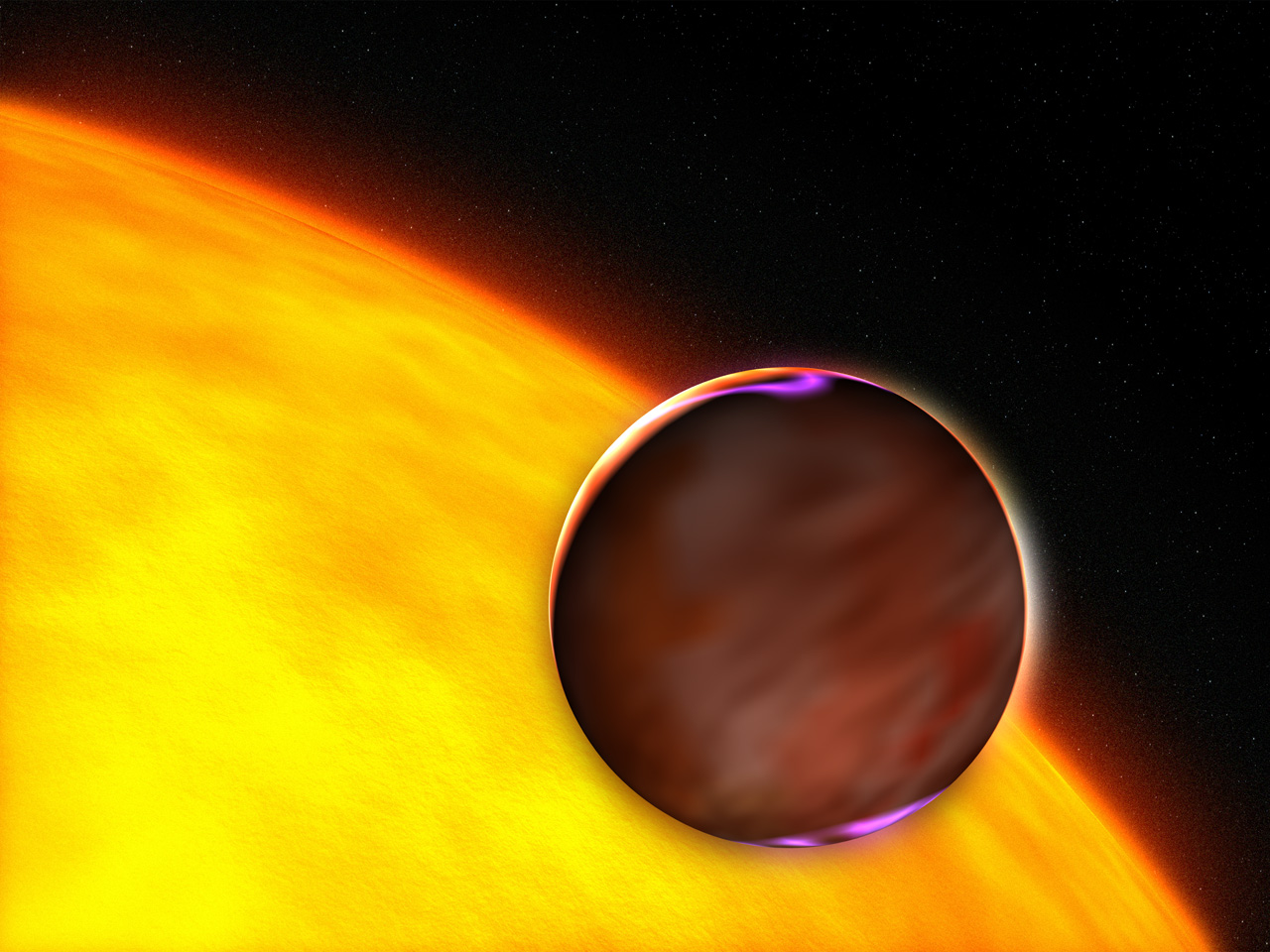- XO-1b
Planetbox begin
name = XO-1 b Planetbox image

caption = Artist's rendition of XO-1 b transiting its sun.Planetbox star
star =XO-1
constell =Corona Borealis
RA = RA|16|02|12
DEC = DEC|+28|10|11
dist_ly = 600 ± 30
dist_pc = 180 ± 10
class = G1V Planetbox orbit
semimajor = 0.0488 ± 0.0005
eccentricity = 0
period = 3.941534 ± 2.7e-05
inclination = 87.7 ± 1.2
ang_dist = 0.244
t_peri = 2453808.917 ± 0.0011
semi-amp = 116 ± 9 Planetbox character
mass = 0.9 ± 0.07
radius = 1.3 ± 0.11
density = 543
gravity_earth = 1.26 Planetbox discovery
discovery_date =17 May 2006
discoverers =Peter McCullough "et al."
discovery_method = Transit andRadial velocity
discovery_site = flag|France
discovery_status = Published Planetbox catalog
names = GSC 02041-01657 bXO-1 b, also cataloged as GSC 02041-01657 b, is an
extrasolar planet approximately 600light-year s away in theconstellation ofCorona Borealis . The planet was discovered orbiting theyellow dwarf star now designatedXO-1 in2006 .Discovery
In
2006 , an international team of professional andamateur astronomer s discovered aJupiter -sized planet, later named XO-1 b, orbiting aSun -like star. The team, led byPeter McCullough of theSpace Telescope Science Institute inBaltimore , had four amateur astronomers hailing fromNorth America andEurope .McCullough and his team employed a relatively inexpensive telescope called an
XO Telescope , made from commercial equipment, to search for extrasolar planets. This telescope consists of two 200-millimeter telephoto camera lenses, and resemblesbinoculars in shape. It stands on the summit of theHaleakalā volcano inHawaii .From
September 2003 toSeptember 2005 , theXO Telescope detected tens of thousands ofbright star s. In that time, McCullough's team of amateur astronomers studied a few dozen stars they had previously identified as promising candidates for extrasolar planets. The starXO-1 , in particular, was marked as a promising candidate inJune 2005 . The amateur astronomers observed it from June toJuly 2005 , eventually confirming that a planet-sized object was eclipsing it. McCullough's team then turned to theMcDonald Observatory inTexas for information on the object's mass and to confirm it was a planet.Transit
McCullough's team found the planet by detecting slight reductions in the star's
intensity as the planet moved into transit of the star. The light from the star reduces by approximately two percent when XO-1b is in transit. Their observation revealed that XO-1b is in a tight, four-day orbit around its parent star.While astronomers have detected more than 180 extrasolar planets, XO-1 b is only the tenth planet discovered using the transit method. It is only the second planet found using telephoto lenses. The first,
TrES-1 , in the constellationLyra , was reported in2004 . The transit method allows astronomers to determine a planet'smass and size. Astronomers use this information to deduce the planet's characteristics, such asdensity .Radial velocity
The team confirmed the planet's existence by using the
Harlan J. Smith Telescope and theHobby-Eberly Telescope at theUniversity of Texas 'sMcDonald Observatory to measure slight perturbations induced by the planet on its parent star. The radial velocity method allowed the team to calculate a precise mass of the planet, which is slightly less thanJupiter 's. This planet is much larger than its mass would suggest. McCullough has said, "Of the planets that pass in front of their stars, XO-1 b is the most similar to Jupiter yet known, and the star XO-1 is the most similar to the Sun, but XO-1 b is much, much closer to its star than Jupiter is to the Sun."Planetary radius
radius = 130The technique used by the team to find XO-1 b is an innovative method in that it uses a relatively inexpensive telescope to hunt for extrasolar planets. It, however, is limited primarily to planets orbiting close to their parent stars, and only finds planets large enough to cause a measurable depression in starlight.
Space telescopes
McCullough believes the newly found planet is a perfect candidate for study by the Hubble and
Spitzer Space Telescope s. Hubble can precisely measure the star's distance and the planet's size, while Spitzer can photograph infrared radiation from the planet. By timing the disappearance of the planet behind the star, Spitzer can also measure the eccentricity of the planet'sorbit —how much its orbital shape deviates from a circle. A high eccentricity implies a highly elliptical orbit, which would mean that the varying gravitational force from its parent star must heat the planet, expanding itsatmosphere and perhaps explaining why the object's diameter exceeds the expectation from its calculated mass.Physical characteristics
As a planet with a mass comparable to that of
Jupiter in a close-orbit around its star, this planet falls into the category ofhot Jupiter s. Like other known transiting hot Jupiters such asHD 209458 b andTrES-1 , the low density of XO-1 b indicates that this planet is agas giant composed mainly ofhydrogen andhelium .See also
*
51 Pegasi b
*HD 209458 b
*Hot Jupiter
*TrES-1 References
*
External links
*
*
*
Wikimedia Foundation. 2010.
